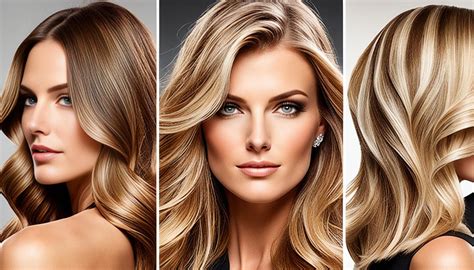Introduction

When it comes to elevating your hair game, two renowned techniques reign supreme: balayage and highlights. Both methods offer captivating results, but understanding their unique characteristics is crucial for determining which approach best aligns with your hair aspirations. This comprehensive article delves into the intricate details of balayage and highlights, providing a thorough comparison to empower you with informed decisions and achieve the hair masterpiece you desire.
What is Balayage?
Balayage is a meticulous freehand painting technique that translates to “sweeping” in French. This artistry involves painting bleach or hair color onto specific sections of hair using a brush, creating a natural, sun-kissed look. The result mimics the effortless radiance of beachy waves, gradually transitioning from darker roots to lighter tips.
Advantages of Balayage:
- Natural and Seamless: Balayage is known for its organic and blended appearance, avoiding harsh lines or obvious demarcation between colors.
- Customizable: The technique allows for tailored color placement, enabling stylists to enhance facial features or complement specific haircuts.
- Low Maintenance: Unlike traditional highlights, balayage requires less frequent touch-ups as the regrowth blends seamlessly into the base color.
What are Highlights?
Highlights, also known as foiling, involve isolating strands of hair and wrapping them in foil before applying bleach or color. The foil acts as a barrier, protecting untreated hair from the chemical process. This technique produces more defined and concentrated areas of lighter color, creating a more dramatic effect.
Advantages of Highlights:
- Vivid and Precise: Highlights offer a bolder and more precise color contrast, perfect for creating statement-making looks or concealing gray hair.
- Versatile: Highlights can be applied in various sizes and patterns, from subtle streaks to chunky pieces, allowing for a wide range of styles.
- Suitable for All Hair Types: Highlights are suitable for most hair types, including fine, thick, or curly hair.
Similarities between Balayage and Highlights:
- Color Transformation: Both balayage and highlights can achieve significant color transformations, adding depth and dimension to hair.
- Professional Expertise Required: These techniques require the expertise of a skilled stylist to ensure precision and optimal results.
- Maintenance: Both methods require occasional touch-ups to maintain vibrancy and prevent color fading.
Key Differences between Balayage and Highlights:
| Feature | Balayage | Highlights |
|---|---|---|
| Technique | Freehand painting | Isolated strands wrapped in foil |
| Appearance | Natural and blended | Defined and concentrated areas of color |
| Customization | Tailored to individual features | More standardized |
| Maintenance | Less frequent touch-ups | Requires regular appointments |
Choosing the Right Technique for You
Consider Your Hair Goals:
- Subtle and Natural: Balayage is ideal for those seeking a low-maintenance, sun-kissed look.
- Bold and Dramatic: Highlights offer a more pronounced color contrast, perfect for creating statement-making styles.
Hair Type and Texture:
- Fine Hair: Balayage can add volume and movement to fine hair.
- Thick Hair: Highlights can create dimension and break up the heaviness of thick hair.
- Curly Hair: Both balayage and highlights can enhance curls, depending on the desired effect.
Maintenance Preferences:
- Low Maintenance: Balayage is a good choice for those who prefer to space out their salon visits.
- Regular Touch-Ups: Highlights require more frequent touch-ups to maintain vibrancy.
Common Mistakes to Avoid
Over-Processing: Avoid excessive bleaching or coloring to prevent hair damage and breakage.
Incorrect Placement: Improper color placement can create unflattering results. Ensure your stylist has a clear understanding of the desired look.
Unrealistic Expectations: Balayage and highlights cannot completely transform hair texture or alter its natural color drastically.
DIY Attempts: Attempting these techniques at home is highly discouraged. Trust a professional stylist to achieve optimal results.
Conclusion
Whether you opt for the subtle artistry of balayage or the bold precision of highlights, both techniques empower you to achieve captivating hair transformations. By carefully considering your hair goals, understanding the technical nuances, and trusting skilled professionals, you can unlock a world of radiant and stylish hair. Embrace the endless possibilities of balayage and highlights, and let your hair become a masterpiece that reflects your unique beauty.
Additional Information
Recent Market Trends:
According to a study by Allied Market Research, the global hair coloring market is projected to reach $12.3 billion by 2027, with highlights and balayage techniques driving significant growth.
Scientific Studies:
A study published in the Journal of Cosmetic Dermatology found that balayage can cause less hair damage than traditional highlighting techniques due to its freehand application.
Emerging Techniques:
Stylists are continually innovating new variations of balayage and highlights. Ombre balayage, for example, combines both techniques to create a soft gradient effect.
Frequently Asked Questions
Which technique is more expensive?
The cost of balayage and highlights varies depending on the length and thickness of your hair, the stylist’s experience, and the salon’s pricing structure. Generally, balayage tends to be more expensive than highlights due to its time-consuming nature.
How long do balayage and highlights last?
The longevity of balayage and highlights depends on the hair growth rate and the frequency of washing. With proper maintenance, balayage can last up to 6 months, while highlights may require more frequent touch-ups every 6-8 weeks.
Can I do balayage or highlights on my own?
While DIY hair coloring may seem appealing, attempting balayage or highlights at home is not recommended. These techniques require precision and expertise to achieve optimal results and avoid damage.
Innovative Applications:
Balayage and highlights can be used creatively to create unique hair designs. Hair painters are embracing techniques such as “hair painting” and “3D balayage” to create multidimensional and artistic effects.
